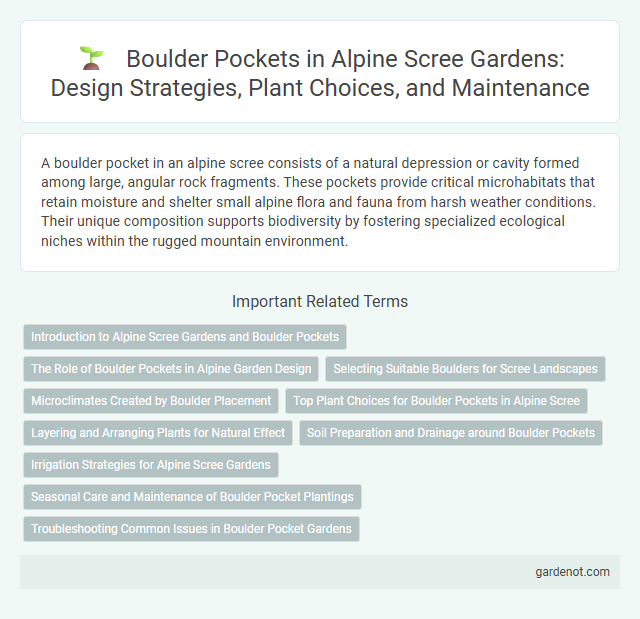A boulder pocket in an alpine scree consists of a natural depression or cavity formed among large, angular rock fragments. These pockets provide critical microhabitats that retain moisture and shelter small alpine flora and fauna from harsh weather conditions. Their unique composition supports biodiversity by fostering specialized ecological niches within the rugged mountain environment.
Introduction to Alpine Scree Gardens and Boulder Pockets
Alpine scree gardens showcase unique ecosystems where Boulder pockets create microhabitats by trapping soil and moisture among large rock fragments. These pockets support specialized plants adapted to harsh conditions, promoting biodiversity in mountainous regions. Understanding Boulder pockets reveals their critical role in stabilizing scree slopes and enhancing ecological resilience.
The Role of Boulder Pockets in Alpine Garden Design
Boulder pockets serve as essential microhabitats in alpine garden design, providing shelter and moisture retention for delicate alpine plants. These natural crevices mimic the rugged terrain of alpine scree, promoting root stability and protection against harsh weather conditions. Incorporating boulder pockets enhances biodiversity and creates visually dynamic landscapes that replicate authentic mountainous environments.
Selecting Suitable Boulders for Scree Landscapes
Selecting suitable boulders for alpine scree landscapes involves prioritizing angular, frost-resistant rocks with rough textures that mimic natural scree formations. Size variation is crucial, with larger boulders providing structural stability and smaller fragments filling gaps to enhance drainage and support native flora. Placement should reflect natural scree dynamics, ensuring boulders are partially embedded and spaced irregularly to promote ecological balance and aesthetic authenticity.
Microclimates Created by Boulder Placement
Boulder pockets within alpine scree generate microclimates by creating sheltered niches that moderate temperature extremes and retain moisture, fostering diverse vegetation and specialized fauna adapted to these unique conditions. The spatial arrangement of boulders influences sunlight exposure, wind protection, and soil accumulation, which collectively support microhabitats distinct from the surrounding terrain. These microclimates enhance biodiversity by providing refuge and resources essential for survival in harsh alpine environments.
Top Plant Choices for Boulder Pockets in Alpine Scree
Top plant choices for boulder pockets in alpine scree include drought-tolerant species such as Sedum, Saxifraga, and Sempervivum, which thrive in fast-draining, nutrient-poor conditions. These plants exhibit exceptional resilience to temperature fluctuations and minimal soil, making them ideal for establishing stable vegetation in rocky alpine environments. Their deep root systems help anchor soil within the pockets, promoting erosion control and microhabitat diversity.
Layering and Arranging Plants for Natural Effect
Boulder pockets in alpine scree landscapes benefit from strategic layering and arranging plants to mimic natural patterns, enhancing ecological integration. Utilizing hardy alpine species such as saxifrages, sedums, and dwarf shrubs creates textural contrast and promotes soil stabilization within crevices. This careful composition supports moisture retention and shelter for microfauna, fostering a resilient, self-sustaining miniature ecosystem.
Soil Preparation and Drainage around Boulder Pockets
Boulder pockets in alpine scree provide natural microhabitats that require careful soil preparation to enhance plant establishment. Soil around boulder pockets should be well-drained, composed of coarse, nutrient-poor substrates to mimic the natural scree environment and prevent waterlogging. Optimizing drainage through the use of gravel layers or angled surfaces facilitates sufficient aeration and moisture retention for alpine flora resilience.
Irrigation Strategies for Alpine Scree Gardens
Boulder pockets in alpine scree gardens serve as natural reservoirs, capturing and retaining water crucial for plant survival in harsh environments. Utilizing irrigation strategies that mimic these natural water retention properties, such as drip irrigation systems placed directly in boulder pockets, enhances moisture availability without excessive runoff. Efficient water management in these microhabitats supports the growth of specialized alpine flora adapted to nutrient-poor, well-drained conditions.
Seasonal Care and Maintenance of Boulder Pocket Plantings
Boulder pocket plantings in alpine scree environments require seasonal care focused on moisture management during dry summer months to ensure deep root hydration. Regular removal of debris and monitoring for pest infestations prevent damage to established plants in these fragile microhabitats. Preparing pockets for winter entails minimal disturbance and mulching to protect roots from freeze-thaw cycles common at high altitudes.
Troubleshooting Common Issues in Boulder Pocket Gardens
Boulder pocket gardens often face drainage problems due to compacted soil or inadequate substrate composition, leading to root rot and poor plant health. Soil erosion and nutrient depletion are common challenges that require regular monitoring and the addition of organic matter or slow-release fertilizers. Managing microclimates within the pockets by selecting drought-tolerant, alpine-adapted plant species helps mitigate stress from temperature fluctuations and moisture variability.
Boulder pocket Infographic

 gardenot.com
gardenot.com